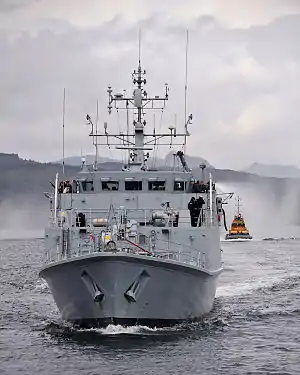Sandown-class minehunter
The Sandown class is a class of fifteen minehunters built primarily for the Royal Navy by Vosper Thornycroft. The Sandown class also serve with the Royal Saudi Navy and the Estonian Navy. The first vessel was commissioned into Royal Navy service on 9 June 1989 and all the British ships are named after coastal towns and cities. They have a secondary role as offshore patrol vessels.
 HMS Ramsey at HMNB Clyde, 2011 | |
| Class overview | |
|---|---|
| Name: | Sandown class |
| Builders: | Vosper Thornycroft, Woolston |
| Operators: | |
| In service: | 1989 |
| Completed: | 15 |
| Active: | 13 |
| Laid up: | 1 |
| Retired: | 1 |
| General characteristics | |
| Type: | Minehunter |
| Displacement: | 600 t (590 long tons; 660 short tons)[1] |
| Length: | 52.5 m (172 ft 3 in) |
| Beam: | 10.9 m (35 ft 9 in) |
| Draught: | 2.3 m (7 ft 7 in) |
| Propulsion: |
|
| Speed: | 13 kn (24 km/h; 15 mph) |
| Complement: | 34 (accommodation for up to 40) |
| Sensors and processing systems: | |
| Electronic warfare & decoys: |
|
| Armament: | |
Development
These small (53 m (174 ft)) fibreglass vessels are single role mine hunters (SRMH) rather than minesweepers. Twelve ships were built for the Royal Navy and three ships were exported to Saudi Arabia. Three Royal Navy vessels were decommissioned following the Strategic Defence Review in 2003; Sandown (January 2005), Inverness (April 2005) and Bridport (July 2004). A further ship, Cromer, was decommissioned and transferred to a training role at the Britannia Royal Naval College in Dartmouth in 2001 as Hindostan.
The three decommissioned vessels were sold to Estonia in September 2006. They were re-equipped with TCS (Tactical Control System) and the Atlas Elektronik Seafox ROV for mine disposal. The sonar system will also be updated. The first ship (ex-Sandown), delivered in 2007, has been named Admiral Cowan,[3] the second (ex-Inverness), was delivered in 2008 and named Sakala and the last (ex-Bridport) named Ugandi in 2009.
Ships in the class
| Navy | Name | Pennant number | Builder | Launched | Commissioned | Status |
|---|---|---|---|---|---|---|
| Cromer | M103 | Vosper Thornycroft | 1990 | 1992 | Decommissioned, now a training ship at Britannia Royal Naval College (as Hindostan) | |
| Walney | M104 | Vosper Thornycroft | 1991 | 1992 | Decommissioned | |
| Penzance | M106 | Vosper Thornycroft | 1997 | 1998 | In active service | |
| Pembroke | M107 | Vosper Thornycroft | 1997 | 1998 | In active service | |
| Grimsby | M108 | Vosper Thornycroft | 1998 | 1999 | In active service | |
| Bangor | M109 | Vosper Thornycroft | 1999 | 1999 | In active service | |
| Ramsey | M110 | Vosper Thornycroft | 1999 | 2000 | In active service | |
| Blyth | M111 | Vosper Thornycroft | 2000 | 2001 | In active service | |
| Shoreham | M112 | Vosper Thornycroft | 2001 | 2001 | In active service | |
| Al Jawf | 420 | Vosper Thornycroft | In active service | |||
| Shaqra | 422 | Vosper Thornycroft | In active service | |||
| Al Kharj | 424 | Vosper Thornycroft | In active service | |||
| Admiral Cowan | M313 | Vosper Thornycroft | 1988 | 1989 / 2007 | In active service, former HMS Sandown (M101) | |
| Sakala | M314 | Vosper Thornycroft | 1990 | 1991 / 2008 | In active service, former HMS Inverness (M102) | |
| Ugandi | M315 | Vosper Thornycroft | 1992 | 1993 / 2009 | In active service, former HMS Bridport (M105) | |
References
- "Sandown Class Mine Countermeasures Vessels - Specifications". GlobalSecurity.org. 11 July 2011. Retrieved 8 June 2014.
- Ministry of Defence (28 January 2016). "New navigation radar system for Royal Navy". GOV.UK. Retrieved 15 March 2019.
- "Queen Elizabeth II to Hand Ship's Badge to Estonian Navy" (PDF). Estonian Review. 16 (39): 6. 4 October 2006. Archived from the original (PDF) on 27 September 2007. Retrieved 10 June 2011.
- Beaver, Paul (1996). Britain's Modern Royal Navy. Patrick Stephens Limited. ISBN 1-85260-442-5.
External links
| Wikimedia Commons has media related to Sandown-class minehunter. |
- "Mine Countermeasures Vessels - Sandown Class". Royal Navy.